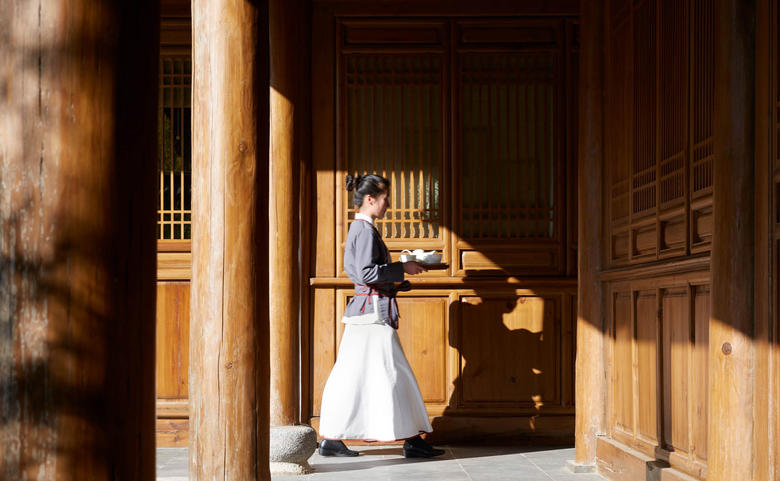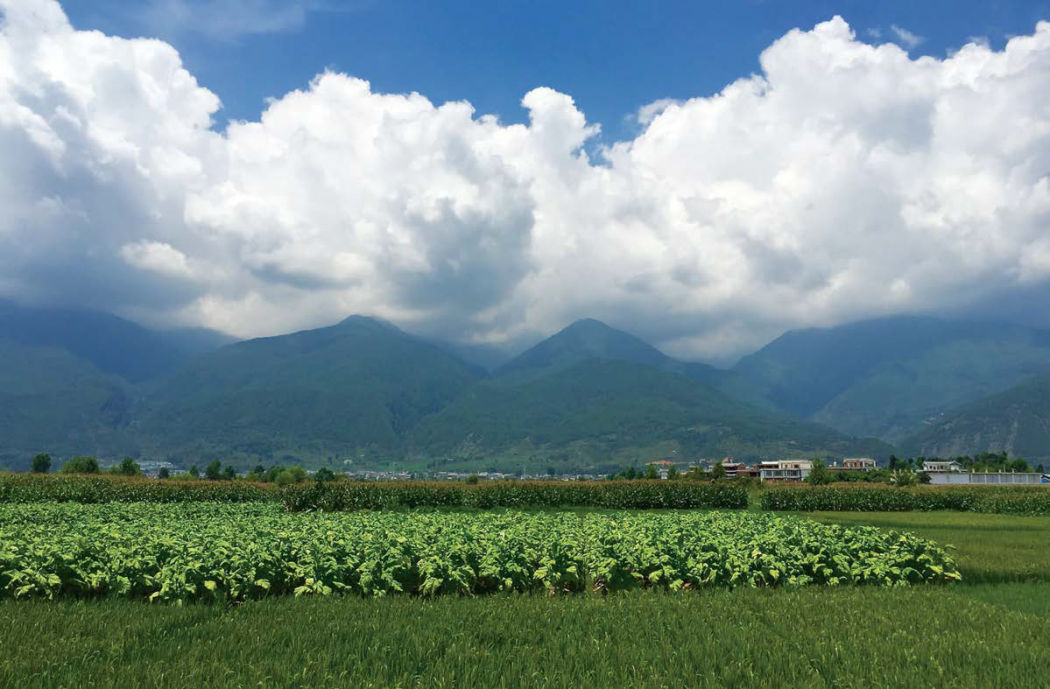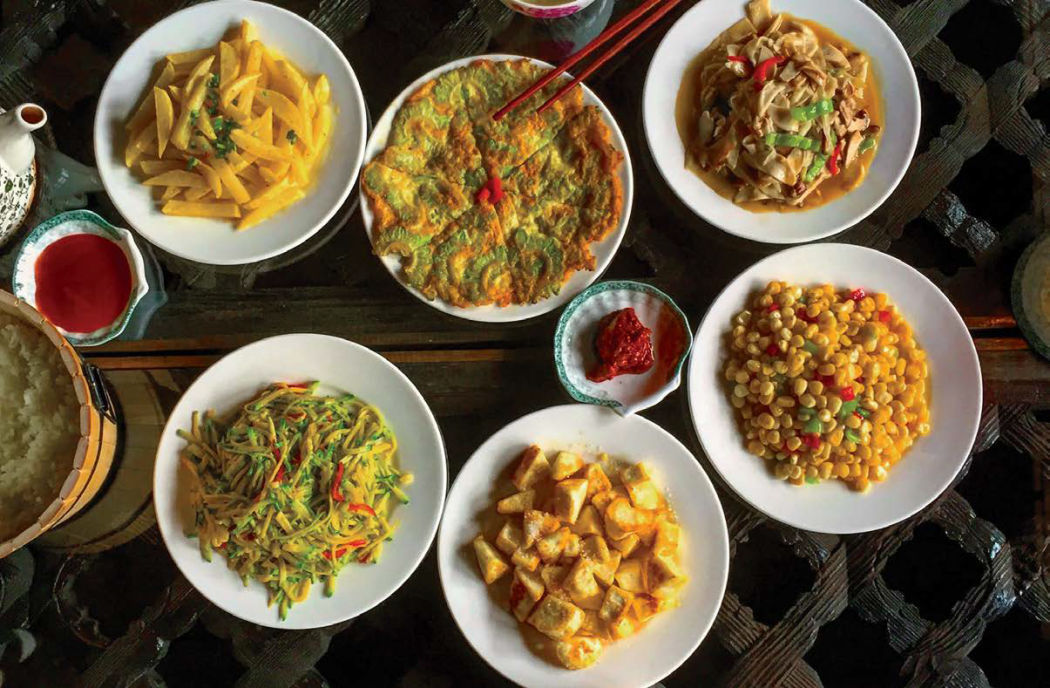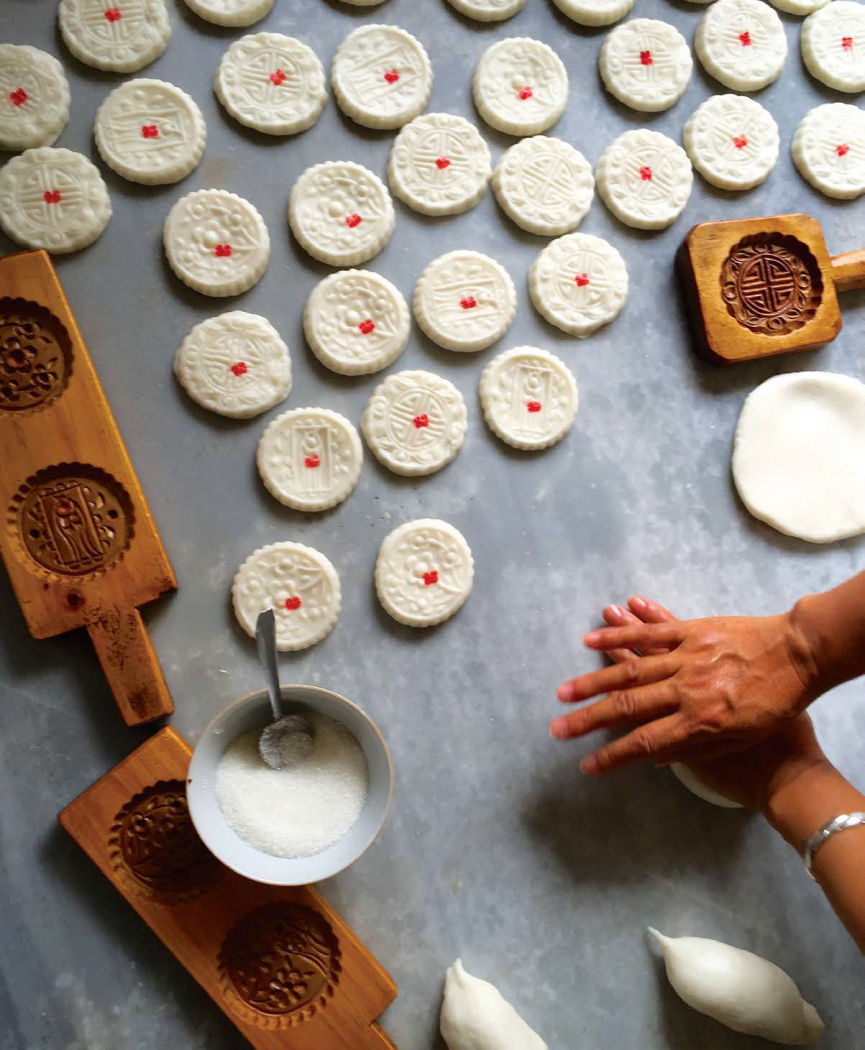
Mushrooms make up merely the first few hundred reasons a gourmand will gorge on Yunnan. Save some space for yak bacon, fresh-baked bread and a bevy of Chinese cheeses.

A PALPABLE EXCITEMENT BRIGHTENS the damp mist that hangs over a patchwork Bai minority village beneath Langwoshan, or Wolf’s Den Mountain. I’m in Heqing, Yunnan, China’s southwestern-most province and have been up since dawn. At 3,800 meters—the altitude giving name to Yunnan, which means Southern Clouds—I’m lightheaded from both the steep climb into this thin air and the thrill of foraging headfirst into the start of mushroom season here. Lush lands hedged by majestic mountains have carved lively villages, home to 26 minority groups, though this part of Yunnan is dominated by the Bai and, on higher ground, the Yi. Their diverse cultures revere and cultivate what seems like every possible type of the fungus. It is generally believed that more than 800 varieties grow in Yunnan and, from late summer through late fall, this land springs to life.
[gallery ids="14217,14257"]“These are our mushroom suppliers and they control this mountain,” says James Bao, food-and-beverage manager of the Amandayan, an hour away in Lijiang, who has accompanied me on this mushroom excursion with executive chef Steven Miao. We are shown a makeshift shelter beneath one of the many pines that dot the steep mountainside where the aptly named pine mushroom grows. Twigs, branches and pine needles protect these noble mushrooms, allowing them to grow to significant sizes; the large and perfect A-grade stems fetch higher prices. A guide uses a spindly branch and carefully brushes the earth away to reveal a sienna round cap with a long white stem. He bends the stick to release a thick-stemmed mushroom called songrong by the locals, and matsutake by the Japanese—who love them. In fact, these rank among the highest quality Chinese exports to Japan where, in 36 hours, they will sell in Tokyo for as much as ¥600 per gram.
On lower ground, in a humble tented kitchen, we sit down to a feast of thick golden and white niuganjun, better known as porcini, thin pale raw shavings of just-picked songrong, thick slabs of Yunnan’s revered cured country ham, a warming chicken soup flecked with dried shitake, along with a plateful of potato wedges tossed in chili. This is an immersive celebration into Yunnan’s brilliant local cuisine, little known outside China. Even if we weren’t ravenous (which we are), I’d marvel at eating a mushroom that an hour ago, I’d plucked from the wild.
WITH ITS WEATHERED, postcard-perfect wooden houses, Lijiang’s Old Town was declared a UNESCO World Heritage site in the late 1990s. I first visited five years ago and have come back to this area for mushroom season, and to gorge myself on an array of culinary secrets you’ll never find on a Cantonese dim sum menu. Hand-pulled cheeses, pumpkin-colored buckwheat pancakes, baba flatbreads… These edible delights, still made the traditional ways by local ethnic groups, imbue the age-old lanes of Lijiang, Shaxi and Dali with as much authenticity as do the newly restored heritage hotels slowly springing up. I’m here to forage on many fronts.

A stroll around the serene courtyard grounds of Amandayan reveals an old gate that opens onto the ancient gardens of Wenchang Temple across from the hotel’s idyllic teahouse. We’re perched up on Lion Hill, known for its magnificent view over the village of Dayan, better known as Lijiang’s Old Town. Lijiang is best in the early morning, when you can wander the empty pedestrian lanes of this sectioned-off historic grid while the quiet gurgle of ancient water canals trickles calmly alongside stone lanes overseen by white-capped Jade Dragon Snow Mountain, the quintessential Chinese landscape. Local residents, a concentration of Naxi minority, a matriarchal society descended from Tibet, still dress traditionally in blue aprons and caps. Wielding woven basket-backpacks, they head to Zhongyi Market where a bustling kaleidoscope of colors and strange scents brings an incredible sight even to seasoned travelers. Witness the trays of local fermented tofu whose fluffy layer of mold functions like the blue spots in ripe Roquefort. Everywhere, people sell fresh wild mushrooms including smaller stems of songrong; dark, large caps of tiger’s paw; long, curly-stemmed jizhong, meaning “chicken taste;” and dark ruffled ganba, or beef mushroom.
Dinner is an elegant study of local cuisine where chef Miao has taken the bounty of Yunnan and applied Chinese culinary mastery at Man Yi Xuan restaurant. Flavors pop and textures explode in a parade of dishes with local ingredients like Sanchuan huotui, the local aged country ham. Crisp bits of scorched rice along with chewy ganba together elevate humble fried rice to haute cuisine.
[gallery ids="14218,14211"]Though the mushroom menu is not to be missed, Chef Miao sprinkles local tastes as broadly as possible—breakfast the next day, for instance, includes yak bacon made using Chinese charcuterie techniques with local livestock that is rich, salty and intense, a perfect partner to poached eggs.
THE ANCIENT TEA HORSE ROAD was a vital trading route of caravans traveling through treacherous passes that linked Tibet, Burma and Bengal through China’s southwest including what are now Yunnan, Guizhou and Sichuan provinces. Shaxi was a central stop, and I’m heading for a tiny hamlet just outside called Duan Village, which offered one of very few options in the region for overnight stays when I first visited. Today Shaxi has plenty of choices but I crave calm countryside—not to mention cook Duan Jiping’s memorable breakfast baba: a bready pumpkin-hued pancake tinted by local buckwheat, topped by a soft-centered fried egg, and sweetened by local chestnut honey from nearby Mapingguan village. So I return to the renovated guesthouse renamed the Old Theatre Inn and its Dancing Mule Café. I am rewarded by the tasteful upgrades made by owner Chris Barclay. The petite residence still holds its charm with five rooms furnished with local antiques, plush beds and modern bathrooms, and Duan’s pancakes are as delicious as ever.
[gallery ids="14214,14212"]The property’s centerpiece is a three-story playhouse with intricate arched roofs in traditional Bai architecture. Now protected by the Jianchuan county as a historic relic, it is surrounded by verdant fields of rice and tobacco. Local Bai ladies run the inn, and, with advanced notice, anything can be arranged including a cooking demonstration or a seasonal mushroom hike, for which, of course, I signed up. Our quest is thwarted by rain, as well as impatience when we learn that our young guides had already gone out to forage that morning. But wandering through the incline of forest in the drizzle, I am grateful nonetheless for the beautiful hike… and all my disappointment disappears when I’m handed a generous gift of stunning golden niuganjun—richly scented, pristine porcini mushrooms from the guides’ early hunt. At the Dancing Mule Café, the mushrooms are stir-fried in local Bai style with green chilies and garlic, an abundance of soft sweet mushrooms with a spike of heat that seems unusual, but is how mushrooms are locally eaten.

Barclay and his wife believed that a visit to a local Buddhist temple—where they prayed to Guanyin, the goddess of mercy associated with fertility—blessed them with the birth of a child. In thanks, they personally funded and oversaw the neglected site’s restoration, also a protected relic. Renamed the Pear Orchard Temple for the aged pear trees that surround the grounds, Barclay designed a restaurant within the grounds specializing in local dishes. Sweet kernels of yellow corn, strips of yellow squash with garlic, and cubes of golden-fried local cheese called rubing—made here with bovine milk, but elsewhere with goat’s—were a particular delight. The next morning Ms. Yang, the elegant head cook, brought me to her neighbor, whose two resident cows supplied the milk that simmered in a wood-fired wok. Watching it curdle into a warm ricotta-like fresh cheese, I was desperate for a drizzle of good olive oil and flaky salt, but this was Shaxistyle, and until it was strained into colorful cotton handkerchiefs and knotted into tight bundles, it would not be called rubing.
It was Friday and I cycled towards Shaxi for the traditional market where everything imaginable is sold including a ground display of vibrant colored medicinal barks and roots, twisted buns of clipped human hair and piles of hand-rolled incense. Clusters of Bai women in ruffled hats picked excitedly at the season’s first Sichuan peppercorns. Their citrusy scent tickled the air while their neighboring compatriots arranged knotted bundles of just-made rubing.

All villages have central plazas called Sifang Jie, or Square Street. Shaxi’s is crowned by an abandoned theater that is bordered by small Cafés and shops including one selling cakes of fresh hand-pressed Pu’er tea, a Yunnan specialty. Horse bells jingle and their hooves clop down the cobblestone roads through emerald rice fields as they return, led by cowboy-like Bai guides, from treks to Shibaoshan mountain, a legendary hike that passes through ancient Buddhist grottoes.
At the Karma Café, off the canaled pedestrian path, hidden inside Laomadian Lodge, the first guesthouse I stayed in years ago that sits on the spot of an important trading post of the Tea Horse Road, I ordered tender Tibetan steamed momo dumplings, chabale (summer crust happiness) crispy yak patties, and crunched on a fresh salad with local walnuts while taking in the antiques and artifacts decorating the walls.
DEEP, DARK SKIES COVER the mountains and farm valleys on the road to Dali, now a fast two-hour drive thanks to a new highway. Along the way, between Erhai, the region’s great lake, and the foot of the Himalayas is the small village of Xizhou and the gorgeous Linden Commons, locally known as Bao Cheng Fu. This boutique heritage hotel is the third preservation endeavor by Brian and Jeanee Linden, who have garnered praise and awards for maintaining authenticity and promoting culture while revitalizing an old village without disrupting local life. This elaborate villa, built in 1939, has been returned to its original splendor under strict state council level historic protection status with stunning Bai architecture such as intricate wood carvings, arched roofs and a painted back courtyard wall. A terraced bar overlooks manicured grounds, dotted with ancient stones. The estate’s charms include valuable antiques, collected over the Lindens’ many years in China.
[gallery ids="14215,14219"]In Yunnan, it’s impossible not to marvel at the similarities to Italy’s foodways. At the morning market tour (complimentary to all Linden property guests), a cheese maker stretches mozzarella-like fresh cheese called rushan, or “milk fan” for its appearance after it’s pulled and dried around a bamboo pole. The result is an air-dried cheese that is fried and served with sugar, or grilled and spread with rose petal jam. Nearby, a workshop makes erkuai, a fresh chewy rice noodle. Rice is soaked, steamed, ground and then pressed through rollers like Italian pasta. Popping air bubbles crack loudly as gloved workers shape hot dough on worn slabs of beautifully streaked gray marble, one of Dali’s best-known products. Swift hands twist cooled dough into strings of big beads and press them into carved wooden molds that are quickly released, then inked with a red seal. Large sheets of erkuai hang on bamboo rods drying. They are sold fresh or dried in different shapes with a chewy and heavier texture than Yunnan’s other common soft rice noodle, mixian.

Xizhou is probably best known for it’s legendary baba, an addictive flatbread made savory with pork and scallion, or sweetened with local black sugar, red bean paste and rose petal jam. The easy five-kilometer bike ride to Zhoucheng, where indigo-tie-dyed batik fabric is made by traditionally costumed Bai grandmothers, is dotted with Xizhou baba bakers. Vendors are ubiquitous, cooking their breads in a makeshift oven of stacked metal trays. Throughout the nearby Sifang Jie, colorfully crowned Bai women in pink and red tunics roll baba variations, some with a cracked egg on top of salt pork or a Muslim version with scallion and butter. On a rainy afternoon, I learn to make baba at a cooking class at the Linden Centre. In the kitchen, my floury fingers twist dough bundles just like the street sellers. While they bake, we enjoy drinks at the antiquated bar, each sip heightening the anticipation for our warm breads. They are flaky, filling and comforting, the ideal snack for a rainy day, and I know that when I make these again—and I will—wherever I am, I’ll be transported back up to the clouds.
THE DETAILS
GETTING THERE
China Eastern flies directly from Hong Kong to Lijiang. Thai Airways and SilkAir fly to Kunming International Airport with connections through Lijiang or Dali. Seventy-two-hour transit visas with restrictions are available on arrival for certain passport holders, otherwise visas must be secured in advance. (Check iatatravelcentre.com for details.) Transport by private car from Lijiang to Shaxi and Shaxi to Dali is available via each establishment for approximately RMB600-800 each way.
HOTELS
Amandayan 29 Shishan Lu., Gucheng, Lijiang; +86 888 533 9999; aman.com; doubles from RMB5,003.
Bao Cheng Fu at The Linden Commons 3 Fuchun Li, Xizhou, Dali; +86 872 245 3000; lindencentre.com; doubles from RMB980.
Old Theatre Inn Duan Village, Shaxi, Dali; +86 872 472 2296; oldtheatreinn.com; doubles from RMB520.
RESTAURANTS
Karma Café Laomadian Lodge, Sideng Jie, Shaxi, Dali; +86 872 472 2777; dinner for two RMB170.
Pear Orchard Temple Reserve in advance through the Old Theatre Inn; +86 135 7725 8117; dinner for two RMB200.
Dancing Mule Café The Old Theatre Inn; dinner for two RMB170.
Man Yi Xuan Amandayan; dinner for two RMB350.
Restaurant & Bar at Bao Cheng Fu at the Linden Commons Dinner for two RMB200; drinks for two RMB100.




